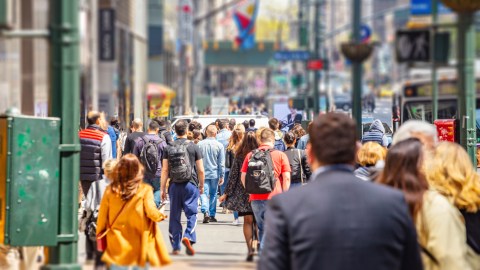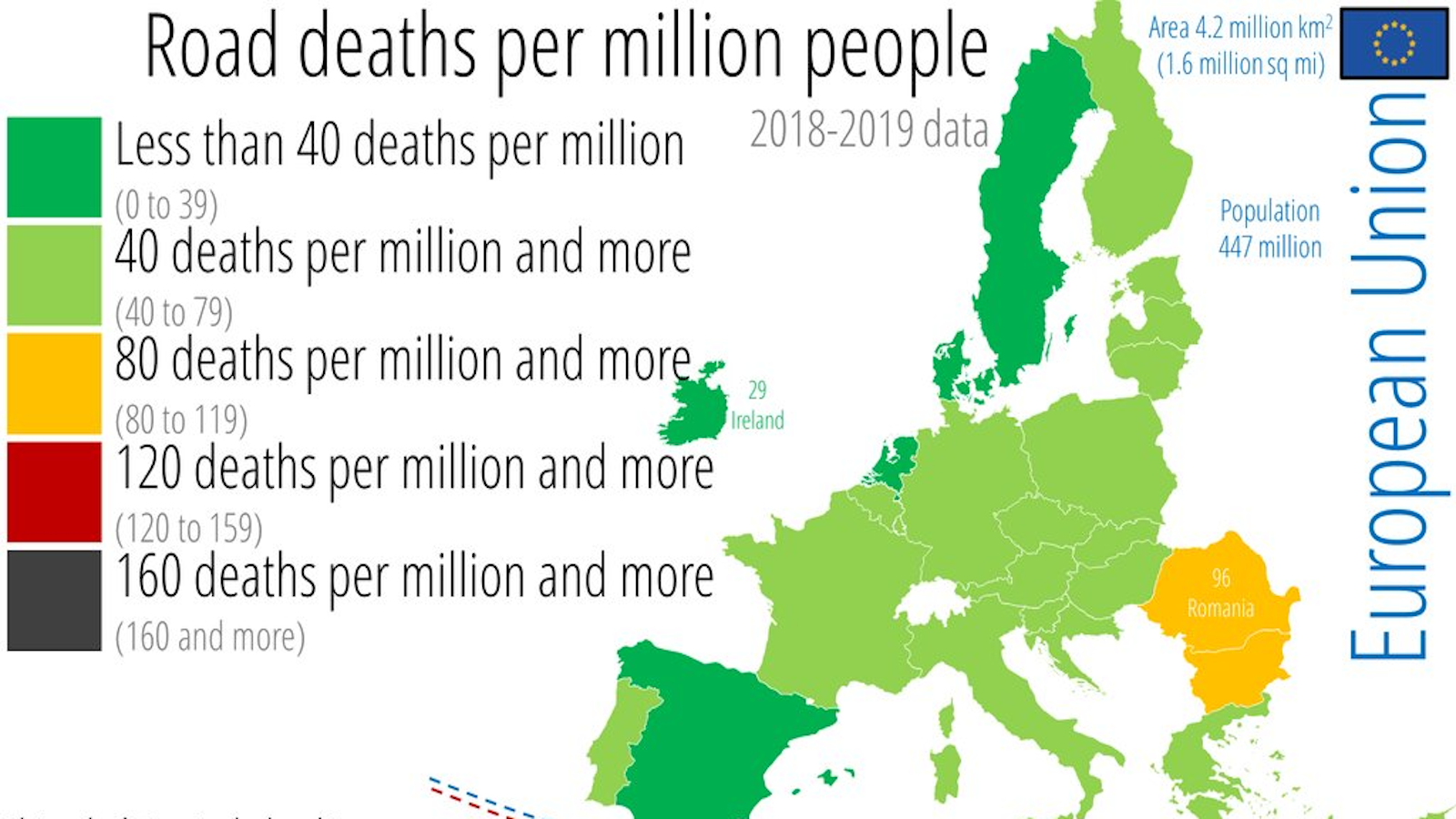Americans don’t walk. Is it laziness — or too dangerous to walk?

- According to a new analysis from researchers at Virginia Tech and Rutgers University, just 12% of all trips in the U.S. are walked. That’s one of the lowest walking rates in the world.
- The dismal rate can be attributed to poor pedestrian infrastructure and adverse policy decisions. With nearly 7,500 pedestrians killed in 2021, the U.S. has a staggeringly high pedestrian fatality rate compared to similar countries.
- Just 30 minutes of walking per day, five days per week is linked with improved cognition and memory, promotes weight loss, and could drastically trim one’s risk of death by anywhere from 20% to 50%.
There are few things more quintessentially human than the way we walk. Millions of years of evolution primed our anatomy and physiology for walking upright on two legs, freeing our arms for other tasks.
Yet in America, relative to other developed nations, this fundamental method of human travel is a rarity. According to a new analysis from researchers at Virginia Tech and Rutgers University published in the journal Sustainability, just 12% of all trips in the U.S. are walked. That’s one of the lowest walking rates in the world. Residents of Finland, Germany, France, and the UK use their legs twice as often to get from point A to point B.
And this disparity is not just driven by the U.S. being more suburban and rural relative to other countries. The researchers found that trips shorter than 2.5 km (1.6 mi) account for 30% of all trips in the U.S., 36% in Germany, 37% in France, 39% in the UK, and 40% in the Netherlands. So Americans don’t have much farther to go for their outings; they simply choose to walk less.
So what’s the reason for Americans’ aversion to walking? Ralph Buehler, a professor of urban affairs and planning at Virginia Tech, and one of the study’s authors, offered a stark explanation: “People walk less in the United States because it’s more dangerous to walk here and walking conditions are worse compared to other countries,” he said in a statement.
Deadly crosswalks
Just how much more dangerous? Buehler and his co-author John Pucher, a professor emeritus of urban planning and policy at Rutgers, calculated a pedestrian fatality rate in the U.S. of 11.2 deaths per 100 million kilometers walked. That’s 5 times higher than in the UK and 7 to 10 times higher than in the Netherlands, Germany, and Denmark. More disconcerting, they found that walking fatality rates in the U.S. rose by 25% between 2010 and 2020. The U.S. was the only country in their analysis to grow more dangerous for pedestrians during that decade.
Given that those numbers are rather abstract, here is a more concrete statistic: According to the Governors Highway Safety Association, 7,485 pedestrians were killed in the U.S. in 2021. To put that into perspective, this number is more than 11 times higher than the number of people killed by the police (667) but less than the number of people murdered (26,031) the same year, according to a CDC database. Additionally, the CDC registered 104,000 pedestrian injuries in 2020 that required hospital emergency room visits.
For Americans who regularly walk, the U.S. is like the Wild West. Buehler places much of the blame for this sorry state of affairs on motor vehicles. “We have designed our communities around the automobile, and a lot of our engineering guidelines for roads have been built to facilitate car movement,” he said. “Roadway designers don’t want to delay vehicles, and, guess what, pedestrian-friendly amenities like crosswalks delay cars.”
Be more like Europe
“In contrast, roadway design standards in European countries have considered walking and pedestrian safety for many decades,” he and Pucher wrote. “Compared with the USA, that has resulted in narrower roadways; overall lower speed limits; slower turn speeds as well as turn restrictions; and lower traffic volumes.”
Buehler and Pucher also cited numerous policy decisions that make walking in America more dangerous. Gas taxes are vastly lower than in Europe, so gasoline costs less than half as much in the U.S. This incentivizes the purchase of large, inefficient vehicles like trucks and SUVs which are vastly more dangerous for pedestrians. The U.S. also permits motorists to drive with a higher blood alcohol level than other comparable countries, putting walkers at risk from inebriated drivers. America also has laxer laws protecting pedestrians from motorists.
To make the U.S. a safer place for walking, Buehler and Pucher recommend redesigning roadways and walkways to be more like those in Europe, instituting more mixed commercial and residential zoning so that businesses and residences can be closer together, and reducing speed limits in popular walking areas.
Making walking less dangerous and more prevalent would be a boon for public health. Just 30 minutes of walking per day, five days per week is linked with improved cognition and memory, promotes weight loss, and could drastically trim one’s risk of death by anywhere from 20% to 50%.





